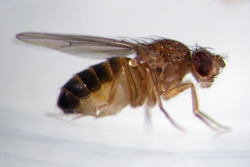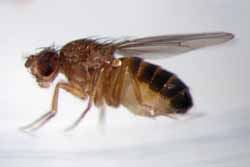Fruit Fly Aggression Studies Have
Relevance To Humans, AnimalsEven the tiny, mild-mannered fruit fly can be a little mean sometimes – especially when there’s a choice bit of rotten fruit to fight over. And, like people, some flies have shorter tempers than others.Researchers in the North Carolina Sate University genetics department have identified a suite of genes that affect aggression in the fruit fly Drosophila melanogaster, pointing to new mechanisms that could contribute to abnormal aggression in humans and other animals.
The study, led by doctoral student Alexis Edwards in the laboratory of Dr. Trudy Mackay, William Neal Reynolds Professor of Genetics, appears online in PloS Genetics.
Feisty flies themselves may not be very scary, but their genes and biochemistry have more in common with those of humans than the casual observer might suspect, and geneticists can subject flies to experiments that simply can’t be done on higher organisms.
To measure aggression, the researchers starved male flies for an hour and a half, then gave them a small food droplet and watched them duke it out, counting the number of times a focal fly would chase, kick, box, or flick his wings at other flies.
“Some animals will very vigorously defend their little food patch, whereas others are relatively polite,” Mackay said. “To determine if this had a genetic basis, we conducted a selection experiment.”
For the selection experiment, Edwards pulled three groups of flies – high aggression, low aggression and control – from the same baseline population, and kept them separate for 28 generations. From each generation, she selected the most aggressive flies from the high aggression group, the least aggressive flies from the low aggression group, and a random sample of the control flies, to be the parents of the next generation.
All the flies started at the same level of aggression, but after 28 generations of selection, the high aggression groups were kicking, chasing and boxing more often, while low aggression groups would hardly fight at all.
Selection experiments only show these kinds of results when there is some genetic control over the trait being selected. In this case, the genetic effect was not very strong – the heritability, or genetic contribution to, aggressive behavior was about 10 percent. The other 90 percent had to be attributed to environmental variation.
“This is definitely not genetic predeterminism,” Mackay said. “It’s a susceptibility. Even in flies, in the constant environment in which we grow them, the environment is more important than the genes. But we are very interested in that small genetic contribution.”
Next, the researchers wanted to know which specific genes affect a fly’s chances of becoming a bully. To find out, they conducted a microarray experiment, a way of comparing which genes are turned on or off, or up or down, in aggressive versus non-aggressive flies.
They found 1,539 genes that were expressed differently in the two groups – and flies only have about 14,000 genes in all. It will take more work to find out which of these genes directly affect aggressive behavior, which ones change as a result of the behavior, and how they do it.
But Edwards started by studying 19 families of flies, each of which had a single mutation in one of the genes identified in the microarray experiment. Fifteen of those 19 mutant families did, in fact, display abnormal aggression compared to non-mutants, confirming the role of those specific genes in aggressive behavior.
Those genes were already known to affect nervous system development, metabolism and immunity, among other things – but none of them had been previously implicated in aggression. Many of them have human counterparts.
“Now we have 15 completely novel genes we can use in the future to investigate aggressive behavior,” Mackay said. “Ultimately we hope to understand the basic biology of this very important trait, because the better we understand it in flies, the more we can develop logical human pharmaceutical interventions.”
HOME
Aggression
Rank theory
Drug Companies
The Warrior Gene
Just For Chemists
Pain and rejection
Hardwired Happiness?
Depression and Chronic Pain
Health, Wealth and Happiness
The Futile Pusuit of Happiness?
Big Pharma and Madison Avenue
Happiness: a Buddhist Perspective
Happy Images Make Depressed People Sad
High Testosterone People Feel Rewarded by Others' Anger


